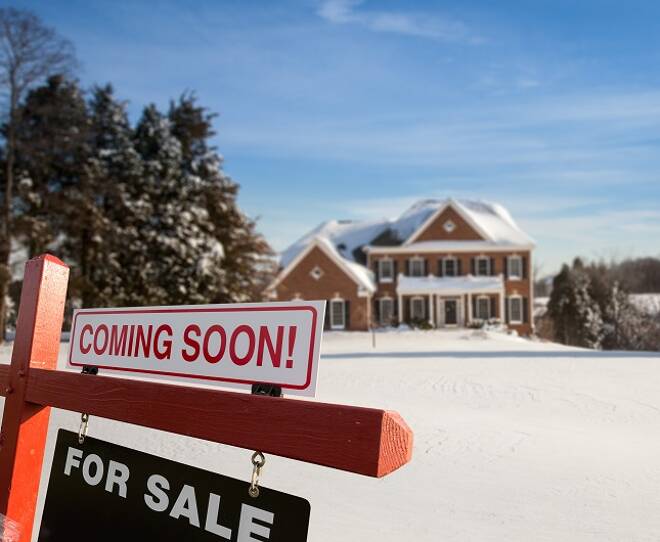Advertisement
Advertisement
U.S Mortgage Rates Hover Close to Record Lows as Applications Tick Up
By:
Mortgage rates rise from record lows, while an easing in lockdown measures sees applications rise. Labor market conditions will be an issue near-term...
Mortgage rates saw a slight uptick in the week ending 7th May to deliver just the 3rd weekly increase in 7-weeks.
30-Year fixed rates rose by 3 basis points to 3.26%. In the previous week, mortgage rates had slid by 10 basis points to 3.23%.
In spite of the uptick, mortgage rates continued to hover close to last week’s record low.
Compared to this time last year, 30-year fixed rates were down by 84 basis points.
30-year fixed rates were also down by 168 basis points since November 2018’s most recent peak of 4.94%.
Economic Data from the Week
Economic data was on the lighter side in the 1st half of the week.
Key stats included April service sector PMIs and ADP nonfarm employment change figures for April and the weekly jobless claims numbers.
The market’s preferred ISM Non-Manufacturing PMI fell from 52.5 to 41.8, with the ADP reporting 20.236m job losses in April.
The markets had anticipated some quite dire numbers, which did prevent a meltdown across the global financial markets.
On Thursday, initial jobless claims jumped by another 3.169m, however, which raised further concerns over the economic recovery.
From elsewhere, better than expected trade data from China supported the demand for riskier assets and U.S Treasury yields.
In spite of the dire employment figures, Treasury yields ticked up mid-week as the U.S government raised the size of its longer-term bond auctions.
On the geopolitical front, rising tensions between the U.S and China and the U.S and Iran were negatives, while the continued easing of lockdown measures was positive.
Freddie Mac Rates
The weekly average rates for new mortgages as of 7th May were quoted by Freddie Mac to be:
- 30-year fixed rates rose by 3 basis points to 3.26% in the week. Rates were down from 4.10% from a year ago. The average fee remained unchanged at 0.7 points.
- 15-year fixed declined by 4 basis points to 2.73% in the week. Rates were down from 3.57% compared with a year ago. The average fee rose from 0.6 points to 0.7 points.
- 5-year fixed rates increased by 3 basis points to 3.17% in the week. Rates were down by 46 points from last year’s 3.63%. The average fee slipped from 0.4 points to 0.3 points.
According to Freddie Mac, mortgage rates stood at or near record lows for a 5th consecutive week supporting refinancing activity.
While purchase demand tumbled by 35% year-on-year, in mid-April, demand has marginally improved in the last few weeks.
Mortgage Bankers’ Association Rates
For the week ending 1st May, rates were quoted to be:
- Average interest rates for 30-year fixed, backed by the FHA, decreased from 3.39% to 3.37. Points remained unchanged at 0.20 (incl. origination fee) for 80% LTV loans.
- Average interest rates for 30-year fixed with conforming loan balances decreased from 3.43% to 3.40%. Points decreased from 0.34 to 0.30 (incl. origination fee) for 80% LTV loans.
- Average 30-year rates for jumbo loan balances decreased from 3.72% to 3.69%. Points increased from 0.33 to 0.34 (incl. origination fee) for 80% LTV loans.
Weekly figures released by the Mortgage Bankers Association showed that the Market Composite Index, which is a measure of mortgage loan application volume, increased by just 0.1% in the week ending 1st May. In the week prior, the Index had fallen by 3.3%.
The Refinance Index declined by 2% from the previous week and was up by 210% from the same week a year ago. In the previous week, the Index had slid by 7%.
The refinance share of mortgage activity fell from 71.6% to 70% of total applications in the week. In the week prior, the share had decreased from 75.4% to 71.6%.
According to the MBA:
- Purchase application volume was unchanged last week, despite mortgage rates falling to a new record 3.40%.
- Refinance applications declined, as lenders offered higher rates for refinances than for purchase loans.
- Other lenders suspended the availability of cash-out refinance loans due to their inability to sell then on to Fannie Mae and Freddie Mac. This also contributed to the decline in refinance applications.
- Purchase volume increased for a 3rd consecutive week, though remains close to 19% below levels seen a year ago.
- The deficit has decreased, however, as more states reopen.
For the week ahead
It’s a relatively quiet start to the week for the Greenback.
April inflation figures are due out on Tuesday and Wednesday, with the weekly jobless claims on Thursday.
While we will expect some influence, geopolitics and news updates on COVID-19 easing measures will likely take center stage.
Treasury yields and demand for mortgage applications could hit reverse should there be an upward trend in new coronavirus cases that leads to a pause in easing lockdown measures.
Another surge in initial jobless claims would also be an issue. With unemployment hitting levels not seen since the Great Depression, credit conditions are only going to get tougher…
About the Author
Bob Masonauthor
With over 28 years of experience in the financial industry, Bob has worked with various global rating agencies and multinational banks. Currently he is covering currencies, commodities, alternative asset classes and global equities, focusing mostly on European and Asian markets.
Advertisement
